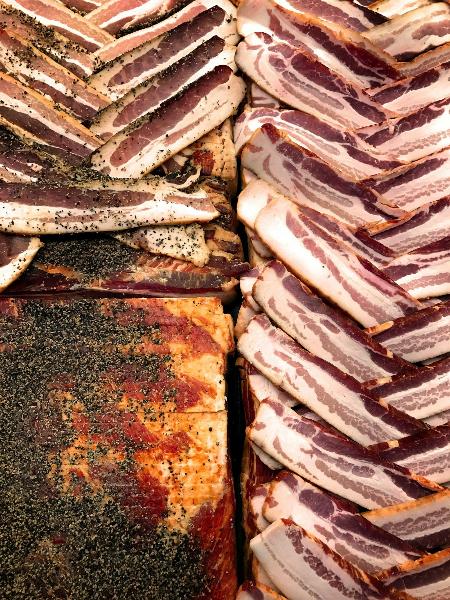Bison 101: Taste, Nutrition, and How to Cook Bison Steak
Share
At Wisconsin River Meats, we love sharing honest, straightforward answers about all kinds of red meat — including the delicious and increasingly popular bison. Whether you’re curious about trying bison steak for the first time or you’re wondering if bison and buffalo are the same animal, you’re not alone.
Bison has grown in popularity across the U.S. because it delivers a rich, satisfying flavor while being leaner and more nutrient-dense than beef. And yet many people still wonder:
-
Are bison and buffalo the same?
-
What does bison taste like?
-
Is bison healthier than beef?
-
How do you cook bison steak?
Let’s dive deep into these questions with the straightforward, down-to-earth guidance you expect from Wisconsin River Meats.

Are Bison and Buffalo the Same?
First, let’s clear up a common confusion: bison and buffalo are not the same animal, even though Americans often use the words interchangeably.
-
Bison are native to North America and Europe. In the U.S., the species is Bison bison, sometimes called American buffalo, but “bison” is the correct term.
-
True buffalo live in Africa and Asia — these include the African Cape buffalo and the Asian water buffalo.
The name “buffalo” stuck in American history because early European settlers saw bison on the plains and nicknamed them buffalo, but genetically and biologically, they are different animals.
So when you see bison on a menu or in the grocery store, you’re eating the great North American bison — the same majestic animals that once roamed the Great Plains by the millions.
What Does Bison Taste Like?
Bison meat has a reputation for being a richer, more robust alternative to beef. Many people describe bison as similar to grass-fed beef but with a slightly sweeter, cleaner, and earthier flavor.
Here’s what makes bison stand out:
-
A mild, slightly sweet flavor that is not “gamey”
-
A leaner texture with less visible fat
-
A fine grain that feels tender and juicy when properly cooked
-
A subtle wild character thanks to its natural grazing diet
In short, bison tastes familiar enough for any beef lover to enjoy but unique enough to feel like a special treat.
When cooked medium-rare and rested properly, a bison steak is tender, flavorful, and deeply satisfying.
Is Bison Healthier than Beef?
Yes, bison is generally considered healthier than beef for several reasons:
-
Lower in fat: bison is a naturally lean meat with about half the fat of beef
-
Fewer calories per serving thanks to lower fat
-
Higher in protein, ounce for ounce
-
Rich in iron, helping maintain healthy red blood cells
-
Packed with zinc, selenium, and B vitamins
-
Lower cholesterol than typical beef cuts
Bison is also often grass-fed and humanely raised, making it an appealing choice for people who care about sustainability and animal welfare.
Of course, like any red meat, moderation is key, but swapping bison in for beef is an easy way to enjoy familiar flavors with a more nutrient-dense profile.

Best Cuts of Bison
If you want to explore bison beyond ground meat, look for these premium cuts:
-
Bison ribeye steak
-
Bison strip steak
-
Bison sirloin steak
-
Bison tenderloin/filet
-
Bison roast (chuck or sirloin tip)
These cuts cook beautifully on the grill or in a cast-iron skillet, just like beef, but they require a bit more attention due to their leanness.
How to Cook Bison Steak
Bison steak is best prepared similarly to lean cuts of beef — but with one essential rule: do not overcook it. Because bison has so little marbling, it can go from juicy to dry in a hurry.
Aim for rare to medium-rare (125–135°F internal temperature) for the best result.
Here’s a foolproof guide to cooking bison steak:
Ingredients
-
Bison steaks (about 1–1.5 inches thick)
-
Kosher salt
-
Fresh cracked black pepper
-
Olive oil or avocado oil
-
A tablespoon of butter
-
Optional: fresh rosemary or thyme
Instructions
-
Bring to room temperature. Pull the bison steaks from the fridge 20–30 minutes before cooking so they cook evenly.
-
Pat dry. Blot any moisture with paper towels. This helps form a good crust.
-
Season generously. A simple sprinkle of kosher salt and cracked pepper is perfect.
-
Preheat a cast-iron skillet over medium-high heat with a tablespoon of oil.
-
Sear the steaks for 2–3 minutes per side to get a rich brown crust.
-
Add a knob of butter with fresh herbs in the final minute, spooning the melted butter over the steak for extra flavor.
-
Check the temperature with a meat thermometer — pull the steak off the heat at 125–130°F for medium-rare.
-
Rest for 5 minutes before slicing to let the juices redistribute.
If you’d rather grill your bison steaks, follow the same principles: medium-high heat, 2–3 minutes per side, and finish with a rest.
Bison Cooking Tips
-
Do not overcook — this is the single most important rule
-
Use a thermometer to avoid guesswork
-
Add a bit of fat if you like, since bison is so lean
-
Keep it simple — let the natural flavor shine
-
Rest your steak before slicing
Because bison is lean, a marinade can also help add moisture. Try a simple marinade of olive oil, balsamic vinegar, garlic, and herbs for a few hours before cooking.
Other Ways to Cook Bison
Beyond steak, bison is delicious in these dishes:
-
Bison burgers (mix in 10–15% beef or pork fat for extra juiciness)
-
Bison chili with tomatoes, beans, and smoky spices
-
Bison stew slow-cooked with root vegetables and herbs
-
Bison meatballs seasoned with garlic, onion, and Italian spices
-
Bison roasts cooked low and slow in the oven
At Wisconsin River Meats, we also love bison turned into snack sticks, summer sausage, or jerky using our time-honored smokehouse methods.
What to Serve with Bison Steak
Bison’s rich, subtly sweet flavor pairs wonderfully with:
-
Roasted root vegetables
-
Wild rice pilaf
-
Mushrooms sautéed in butter
-
Garlic mashed potatoes
-
Red wine reduction sauces
-
Fresh green salads
A good Wisconsin beer or a bold cabernet also complements bison’s earthy notes.

Is Bison Tough?
No — bison is not tough if cooked properly. Because bison is lean, overcooking it will dry it out. Medium-rare is perfect, leaving the steak tender and flavorful.
When handled right, bison is actually more tender than many comparable beef cuts.
Is Bison Gamey?
Generally no. Most people say bison tastes cleaner and milder than venison, with less “game” character. Its flavor is very approachable for beef lovers, making it a great introduction to wild game.
Frequently Asked Questions
Is bison safe to eat rare?
Yes — if handled and cooked safely, medium-rare bison is perfectly safe and delicious.
How long does cooked bison last in the fridge?
About 3–4 days in an airtight container.
Can you freeze bison?
Absolutely. Freeze well-wrapped steaks or ground bison for up to 6 months.
Why is bison more expensive than beef?
Bison are raised on a smaller scale, with more space, and generally on grass — making it costlier but also more sustainable.
How do I store raw bison?
Keep raw bison refrigerated below 40°F, and cook within 2–3 days or freeze.
Why Wisconsin River Meats Supports Bison
At Wisconsin River Meats, we admire bison not only for its incredible taste but also its role in conservation. Bison were nearly wiped out in the 1800s, but thanks to careful stewardship, they have returned to ranches and conservation lands across North America.
We proudly help process bison meat into smoked products, bratwurst, summer sausage, and jerky — always using real hardwood smoke and traditional spice blends to honor the animal and your table.
Final Bison Steak Recap
Here’s your bison steak cooking cheat sheet:
-
Cook hot and fast
-
Medium-rare is perfect
-
Add a bit of fat for flavor
-
Rest before slicing
-
Keep seasonings simple
When you follow these steps, you’ll get a juicy, tender bison steak every bit as satisfying as premium beef — but with fewer calories, less fat, and more iron.
Final Thoughts
Bison is one of the great American meats — nutritious, flavorful, and steeped in history. When you try bison, you’re tasting the landscape of North America, from wide prairies to oak savannas. Its mild, slightly sweet flavor, high protein, and sustainable story make it an outstanding choice for anyone who loves honest, flavorful food.
At Wisconsin River Meats, we’re here to help you make the most of bison: whether you want to process a whole bison, create bison sausage, or explore bison snack sticks, our small-batch smokehouse and skilled butchers can guide you every step of the way.
Want to experience real bison flavor?
Contact us here and we’ll help you get started with the best local meats and wild game processing.

